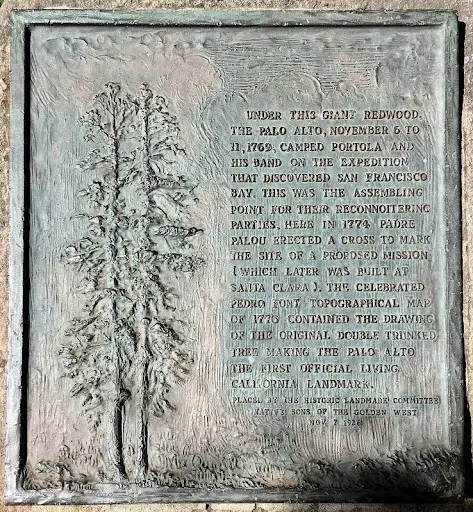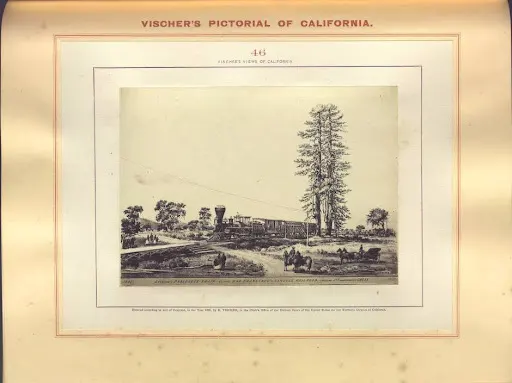I was not expecting one of the most significant landmarks in the entire state of California to be a rather unimpressive-looking redwood tree, situated by the Caltrain tracks a few miles away from where I live. It was taller, as most redwoods tend to appear, in comparison to the surrounding fauna, but not so tall as to strain my neck as I peered upwards. I frankly wasn’t sure why we hopped into the car just to see this specific tree when plenty of taller redwoods were seemingly more deserving of landmark status. It would later become apparent that it wasn’t a matter of size to begin with.
The story of this tree began a millennium ago, as a coast redwood seed took purchase on the banks of a creek, far from the mountains it was born on. Nourished by alluvial soil and the steady stream of water, the sapling thrived in an area where most other redwoods would not (Wright). The twin trunks of the tree grew to a height far above the cover of the dispersed oaks on this dry and temperate land, to the point that the indigenous Ohlone Indians were likely able to see it from the head of the peninsula (Bowling). The tree oversaw the Ohlone’s balance between a hunter-gatherer lifestyle and a trade network between tribes for the last 1,000 years of their civilization (Herzberg). Both of these behaviors were enabled by their proximity to the water, where the Ohlone would venture out in balsa wood boats to fish, collect materials and travel (Herzberg). Though tribes mainly lived in areas bounded by natural watersheds, they looked to this lone redwood as a beacon and possibly as a symbol of reverence.
In 1769, the explorer and governor of Baja California, Don Gaspar de Portola, was among the first Europeans to look upon this tree. On an expedition sanctioned by the Spanish government into the newly-claimed territory of Alta California, he and his men were looking for Monterey Bay (Smith). After their interactions with the Quiroste tribe, who revived the scurvy-ridden soldiers and pointed them toward a bay to the north, the men realized that they had passed Monterey long ago (Herzberg). The expedition wasn’t entirely fruitless, however, as the land in and around the bay was well documented, including the lone redwood that jutted out from the plains. On their hike home, the men famously took shelter under ‘Palo Colorado,’ the redwood, which by now was a familiar guide to orient themselves on the peninsula (Crespí).
Though De Portola and his men left for San Diego soon after, they set the stage for the end of the Ohlone in the San Francisco Bay Area. Between 1770 and 1797, several Spanish missions were built across the peninsula (Weiser-Alexander). Palo Colorado served as a landmark for Padre Francisco Palóu, who erected a wooden cross at its base to mark the site of the Santa Clara Mission (Whittle). Almost as if it was christened with the surrounding land, the tree became officially known to the Spanish by the name ‘El Palo Alto,’ the tall stick (Bowling). In the following years, El Palo Alto would witness the decline of the indigenous inhabitants it had once looked over, as mission fathers began to convert the Ohlone to christianity (Smith). Packed within the walls of the missions, unable to travel anywhere other than mission-sponsored settlements, the converts succumbed to European disease and high child mortality at an exacerbated rate (Library of Congress). The population dwindled to ten percent of the pre-mission population, and when Mexico took control of California and abolished the mission system the remaining descendants scattered across the country (Weiser-Alexander). As such, the era of the Ohlone people came to an abrupt end.
With little indigenous resistance, the Bay Area began to develop at an incredible speed. Following California’s handover to the United States, many Americans flocked to the state during the Gold Rush. The influx in population and investment attracted many entrepreneurs looking to turn a profit, including Leland Stanford, who came west in 1852 after a fire destroyed his law office (Sparks). Stanford set up a grocery shop and a wholesale shop, then became involved in politics, and went on to amass a fortune by investing in the Central and Southern Pacific Railroads (Sparks). Though he largely took part in Gilded age economic practices due to his political standing, Stanford spent much of his wealth creating a private university in memory of his late son (Sparks). Stanford established the Leland Stanford Junior University on his stock farm, located in close proximity to El Palo Alto (Bowling). As the university was funded, the surrounding town began to prosper economically and was incorporated in 1894 as the city of Palo Alto, named after the famed tree (Bowling). Through his contributions to higher education and Californian industry, Stanford played an essential role in transforming the Bay Area into the west coast’s primary technological hub. All the while, El Palo Alto remained a symbol of the land, having been officially enshrined in the Stanford University and Palo Alto City seals (Bowling).
However, Stanford’s influence did not come without its drawbacks. The cost of expanding Palo Alto included the loss of several Ohlone burial mounds scattered throughout the region (Wright). These contained the remnants of the forgotten civilization; a mortar and pestle, flint arrowheads, animal and human skeletons, assorted ornaments, and sea shells were among the artifacts retrieved by the Stanford academic community before the mounds were razed to the ground (Wright). Not even the phosphate-rich debris from the excavations was spared, as enterprising individuals marketed it under the moniker, “Indian Mound Top Soil” (Wright).
The developing city took a heavy toll on El Palo Alto, too. Though the story goes that one of its trunks fell during a heavy storm in the mid 1880s, it is speculated that the trunk was actually cut down during the construction of the Southern Pacific Railroad, which stopped right below the tree (Robbins). The surviving trunk, already weakened, began to die off at the top, likely due to the exposure to pollution and soot from passing trains (Robbins). Lowering water tables caused by the introduction of several wells and decreased rainfall in the Bay Area also contributed to its ill-health, as coast redwoods generally thrive in cool, foggy areas of high precipitation (Robbins). Appearing gaunt and sickly, it seemed as if the tree was nearing its end. A local fraternal organization, the Native Sons of the Golden West, presented El Palo Alto with a bronze plaque set in a granite boulder to honor its millennium of existence (Bowling).
Fortunately, with the help of the surrounding community, El Palo Alto was able to make somewhat of a recovery from its near-death state. In the 1950s, a city arborist, George Hood, connected an irrigation system to the tree to mist water into its crown (Robbins). In addition, the wells were eventually capped to bring water tables back up, restoring the redwood’s primary source of water (Robbins). Soil and mulch was filled in near the tree’s base, and the tree has been periodically pruned and treated for termites (Bowling). El Palo Alto will have to fend off train smoke for a little longer, as the plan to electrify the Caltrain has been postponed till 2024 (Robbins). In spite of this, and other problems yet to be dealt with, arborists in Palo Alto expect the redwood to overlook the Bay Area for at least three more centuries (Dockter).
El Palo Alto stands as a reminder of a time long past and a warning of what might be to come. The redwood, at a stunning 1,076 years old, has witnessed the height and the collapse of the Ohlone civilization and sheltered the Spanish expedition that paved the way for colonization of the Bay Area. It has weathered natural disasters and man-made industrial projects, and continues to battle to survive. El Palo Alto is undoubtedly a symbol of pride to the inhabitants of Palo Alto, including myself. However, it has only survived so long because it was singled out and venerated by the city for its historical significance. While multiple experts and officials have worked for the better part of a century to preserve and protect El Palo Alto, there are many more redwoods who haven’t been as lucky in encountering climate, terrestrial and population changes in their vicinity. We can choose to believe in El Palo Alto as a symbol of persevering through difficulty, inspiring us to remember the history of our land and to foster the environment that we will one day pass on.
I beheld in the distance a tree of immense stature rising above the plain of oaks like a tall tower (“El Palo Alto”).
- Padre Pedro Font (Wright)
 1. El Palo Alto Marker (Baker)
1. El Palo Alto Marker (Baker)
 2. Evening passenger train on the San Francisco - San Jose railroad, crossing South Francisquito Creek (Vischer)
2. Evening passenger train on the San Francisco - San Jose railroad, crossing South Francisquito Creek (Vischer)
 3. The twin-trunked El Palo Alto in 1875 (Bowling)
3. The twin-trunked El Palo Alto in 1875 (Bowling)
Sources
Bowling, Matt. “Palo Alto History.” Palo Alto History, www.paloaltohistory.org/el-palo-alto.php. Accessed 7 Nov. 2021.
Crespí, Juan, and Herbert E. Bolton. Fray Juan Crespi, Missionary Explorer on the Pacific Coast, 1769-1774. Berkeley, Calif., U of California P, 1927., 1971, p. 203–228, Hathi Trust. catalog.hathitrust.org/Record/000288788.
Dockter, Dave. “The El Palo Alto Redwood Tree - Arborist Report and Appraisal.” Californians Advocating Responsible Rail Design (CARRD), 18 Sept. 1999, www.calhsr.com/wp-content/uploads/2010/03/The-El-Palo-Alto-Redwood-Heritage-Tree-1.pdf.
Herzberg, Samuel. “Marking History with the Ohlone-Portolá Heritage Trail Project.” Northern California Section of the American Planning Association, 27 Mar. 2019, www.norcalapa.org/2019/03/marking-history-with-the-ohlone-portola-heritage-trail-project/.
Library of Congress. “The Missions | Early California History: An Overview.” The Library of Congress, www.loc.gov/collections/california-first-person-narratives/articles-and-essays/early-california-history/missions/.
Robbins, Jim. “The Unlikely Survival of the 1,081-Year-Old Tree That Gave Palo Alto Its Name.” The New York Times, 14 July 2021, www.nytimes.com/2021/06/26/us/palo-alto-redwood.html.
Smith, Laurasia H. “Remembering the Ohlone, Then and Now.” Golden Gates National Parks Conservancy, www.parksconservancy.org/article/remembering-ohlone-then-and-now.
Sparks, Evan. “Leland Stanford.” Philanthropy Roundtable, www.philanthropyroundtable.org/almanac/people/hall-of-fame/detail/leland-stanford.
Vischer, Edward. “Evening Passenger Train on the San Francisco - San Jose Railroad, Crossing South Francisquito Creek.” The Claremont Colleges Digital Library, Honnold Mudd Library. Special Collections, 1867, ccdl.claremont.edu/digital/collection/vdp/id/1259.
Weiser-Alexander, Kathy. “Ohlone Indians of California – Legends of America.” Legends of America, Nov. 2021, www.legendsofamerica.com/ohlone-indians/.
Whittle, Syd, and Craig Baker. “El Palo Alto Historical Marker.” The Historical Marker Database, 20 Sept. 2021, www.hmdb.org/m.asp?m=41255.
Wright, Benjamin. “The Indian Mounds Memorial Rock of Palo Alto.” Cymbalinesite, 27 May 2018, cymbalinesite.wordpress.com/2018/05/27/the-indian-mounds-memorial-rock/.